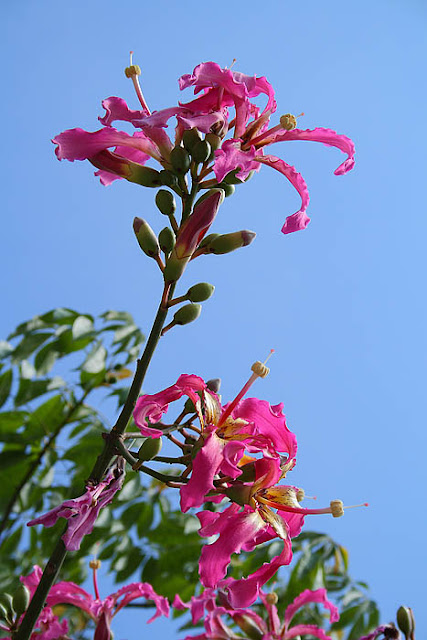yucan, samohú, samuhú, copadalick, mandiyú-rá, mandiyú, palo borracho rosado, palo rosado, palo borracho de flor rosada, algodón, algodonero, palo botella, palo barrigudo, árbol de la painera, painera de Corrientes, painero, peinera, árbol botella, árbol de lana, toborochi, toborochi rosado, paina de seda, árvore de la, paineria fêmea, lupuna, ávore de paina, barriga dágua, bomba dágua, paineria branca, paineira de espinho, árbol de la seda, ceiba de Brasil, kapoc.
 |
| Palo borracho (Ceiba speciosa) in full leaf. (by-nc-nd) |
It belongs to the same family as the baobab and the kapok, and its natural habitat is the north-east of Argentina, Paraguay, Uruguay and southern Brazil. The tree is resistant to drought and moderate cold. Its bottle-shaped trunk can measure up to 2 metres (7 ft) in girth. The curious thing about this tree is that it's studded with thick conical prickles which serve to store water for dry times. In younger trees, the trunk is green due to its high chlorophyll content, with age it turns to grey.
A flowering silk floss tree is a feast for the eyes, and even more so when monarch butterflies, attracted by its nectar, flutter around it. In return they pollinate the tree.
The fruit pods contain bean-sized black seeds surrounded by a mass of fibrous, fluffy matter reminiscent of cotton or silk, hence the name. The cotton inside the fruit pods, although not of as good quality as that of the kapok tree, has been used as stuffing for pillows and thermic insulation.
But these aren't its only virtues: the wood of this tree is light, soft and flexible, and is used in packaging, to make canoes, as wood pulp to make paper, and in ropes. From the seeds it is possible to obtain vegetable oil (both edible and industrially useful). Although it's a shame to cut down such a beautiful tree for profit.
Thankfully, The floss silk tree is cultivated mostly for ornamental purposes.
| Silk floss tree, Palo borracho (Ceiba speciosa) spiky branches. (by-nc-nd) |
 |
| Silk floss tree, Palo borracho (Ceiba speciosa) blossom (© 2012 LightColourShade. All rights reserved) |
+flower.jpg) |
| Silk floss tree, Palo borracho (Ceiba speciosa) flower (© 2012 LightColourShade. All rights reserved) |
+flowers+close-up.jpg) |
| Silk floss tree, Palo borracho (Ceiba speciosa) flowers close-up (© 2012 LightColourShade. All rights reserved) |
What an amazingly beautiful tree! And its flowers - like orchids. It is, to my mind, one of those natural wonders just there for our finding.
ReplyDeleteThank you again for this beautiful post.
Thank you, I'm glad you liked the flowers.
DeleteI think most people spend their lives just passing by the things without noticing their beauty, but as you so rightly mentioned these things are waiting for the beholder.
Personally, I'm a fan of the "slow life" concept, I turn my head in every direction no matter where I'm going.